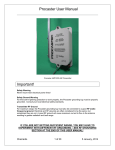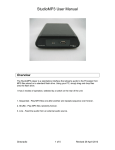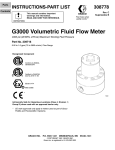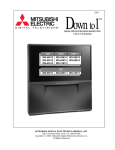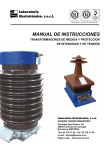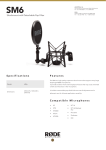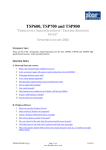Download PROCASTER AMTX100 AM Transmitter Installation and Operation
Transcript
PROCASTER AMTX100 AM Transmitter Installation and Operation (PRELIMINARY) Installation PROCASTER™ contents • • • • • • PROCASTER™ transmitter module Studio interface module Antenna tubes (3 pieces) Hardware AC wall adapter Assembly/installation instructions Changes or modifications not expressly approved by ChezRadio could void user's authority to operate the equipment. SAFETY WARNING TO PREVENT ELECTROCUTION ALWAYS BE AWARE OF NEARBY ELECTRICAL POWER WIRING AND MOUNT THE ANTENNA FAR ENOUGH AWAY SUCH THAT IF THE ANTENNA FELL DOWN, THERE WOULD BE NO CHANCE OF CONTACT. Before starting your installation, consider the following carefully: • • • • • Is the chosen frequency clear? Are there nearby obstructions such as buildings, trees and power lines etc? Where are you going to mount the transmitter? Where are you going to ground it? What range are you expecting to get? For a successful installation, follow these steps... Page 1 of 9 PROCASTER AMTX100 AM Transmitter Installation and Operation Step 1. Choose a Quiet Channel Drive around your chosen broadcast area and listen for clear channels. Note: car radios are usually more sensitive than portables, so that should be considered too. If you want to broadcast at night, you would have to check if the channel is clear then. It's more difficult to broadcast at night because changes in the ionosphere cause signals from higher-powered radio stations to reach your broadcast area; so bear that in mind. Try to choose one of the highest 42 channels available for the PROCASTER™ by setting the option switches accordingly. The higher the frequency, the better the range because of the restrictive short antenna length. Step 2. Install Location Higher mounted antennas usually result in better range. The PROCASTER™ mounting bracket is intended for mounting on a flat vertical surface. Optional kit # XXXXX allows pole mounting. Make sure you can access the transmitter for tuning once it is in its final position. A good height above earth ground is about 25 feet. The roof of a 2-storey building is a good choice. Step 3. Assemble Antenna Three aluminum tubes (large 5/8", medium 1/2" and small 3/8") are assembled together to form a 103 inch antenna. These sections are held together using 2 stainless steel pipe clamps. • • • • Join the large tube to the medium tube o slide a pipe clamp over the mid-point of the slotted end of the large tube o insert the medium tube into the large tube lining up the black dot o tighten pipe clamp snugly using a 1/4" nut driver Join the small tube to the medium tube o slide a pipe clamp over the mid-point of the slotted end of the medium tube o insert the small tube into the medium tube lining up the black dot o tighten pipe clamp snugly using a 1/4" nut driver Fasten the assembled mast to the transmitter using (2) #10 lock-washers and (2) locknuts - refer to E o Use a screwdriver to prevent the bolt from turning while tightening the nuts - refer to F o Tighten snugly (don't over-tighten) Antenna assembly is now complete (antenna assembly pics) Step 4. Mount External Transmitter In all mounting cases, ensure you can reach the unit for tuning once installed! Direct wall mounting Mount the PROCASTER™ directly to a flat vertical surface using the 4 holes in the case mounting plate. Make sure that there is sufficient space between the antenna mast and the rear wall such that snow/ice does not cause a short. (direct on wall) Page 2 of 9 PROCASTER AMTX100 AM Transmitter Installation and Operation Direct wall mounting with standoff brackets Use Radio Shack 4 inch Antenna Mast Wall Mount kit catalog # 15-883 to hold the PROCASTER™ further away from the wall. (direct on wall with brackets) Pole mounting For pole mounting use a pair of 2 inch spacing U-bolts with formed curved backing plates – like the ones in the following picture. The backing plate prevents the case mounting areas from bending when tightening onto the pole and makes for a more secure installation. (pole mounting) Step 5. Install Ground Connect the copper grounding lug shown below to a suitable ground. (grounding lug) Good grounding is extremely important for optimum antenna performance and is required for safe operation of the lightning protection circuitry. Typical grounds include: • • • • Copper clad steel grounding rod at least 8 ft into earth ground Water pipe ground Radial ground system Metal roof Warning: FCC rules (47 part 15.219) state:” the total length of the transmission line, antenna and ground lead (if used) shall not exceed 3 meters.” [3 meters = 118 inches] The PROCASTER™ has an attached 103 inch antenna measured from its tip to the lower mounting bolt which is the connection of the transmitter output. It has no transmission line. A 15 inch maximum ground lead is allowed from the grounding lug to a massive ground. Step 6. Connect Power and Audio Wiring The PROCASTER™ connects to the studio interface with 4 conductor CAT3 wire. Because the audio is balanced and the power consumption is low, several hundred feet of wire can be used without issue. Proceed as follows: • • • Open the PROCASTER™ cover by loosening the 3 cover clamps Insert 4 conductor CAT3 wire through liquid-tight grommet on the underside Connect: o RED: +12V o GREEN: 0V o YELLOW: AUD + Page 3 of 9 PROCASTER AMTX100 AM Transmitter Installation and Operation • o BLACK: AUD Tighten nut on liquid-tight grommet (wiring pic) Step 7. Connect to indoor Studio Interface Module Bring the 4 conductor CAT3 cable into the studio area. Proceed as follows: • • • • Remove the 4 rubber feet from the studio interface enclosure Slide off the cover Pass the 4 conductor CAT3 cable through the rear bushing Connect: o RED: +12V o GREEN: 0V o YELLOW: AUD + o BLACK: AUD - (rear of studio interface) Step 8. Connect an audio source The PROCASTER™ is fitted with a universal 3.5mm stereo input jack similar to I-pod™ and modern car audio equipment. It has been designed to accept stereo left and right audio channels and mixes them into a mono signal. (front of studio interface) The built-in audio processor has a fairly wide accommodation range and will automatically adjust audio level for optimum sound quality. In addition there is an input audio level adjustment control (normally set at mid-point) accessible through the front panel using a small jewellers screwdriver. The audio level can be set from approximately 200mV to 3V which will accommodate most audio devices. Page 4 of 9 PROCASTER AMTX100 AM Transmitter Installation and Operation Step 9. Power Up the Procaster ™ Connect the AC wall adapter. Step 10. Choose Channel Frequency To choose the desired broadcast channel, refer to the Option Switch section. Note: the option switch also allows additional settings to be made. Step 11. Tune Antenna Once the broadcast channel is set, turn the antenna tuning capacitor using a small bladed screwdriver until a maximum reading is seen on the tuning meter. Make sure to stand clear of the antenna as body capacitance will affect tuning. If the reading is not "sharp" and strong, re-check your ground connection. (tuning) Antenna tuning is now complete. (Now that was easy!) Step 12. Final Checkout & Adjustments Check your sound level and range by listening on a radio. The broadcast signal should be clear and strong when closer to the transmitter, with more noise heard the further you move away. The built-in audio processor is what makes the PROCASTER™ sound like a big station. If you want to use your own external audio processing equipment, the PROCASTER™ audio processor can be disabled by changing the option switches. The PROCASTER™ audio processor can be adjusted to suit personal preferences as follows: Compression: Turning the compression control CW boosts quieter parts of the audio to be more equal to the louder parts. This makes the overall audio louder resulting in a stronger signal and greater range. The tradeoff is the subjective audio quality depending on the level of compression. Modulation Depth: Turning the modulation depth control CW increases the audio modulation level of the AM signal. Limiting: Limiting is automatic to prevent sideband 'splatter' and both the above adjustments have no affect on the 'hard limiter' built into the audio processor. Congratulations! You have set up your broadcast station. Page 5 of 9 PROCASTER AMTX100 AM Transmitter Installation and Operation Specifications Outdoor Transmitter Module Modulation scheme AM Harmonic suppression >30dB 100mW input power control Automatic self-regulating Frequency selection 42 channel PLL Frequency range 1290kHz to 1700kHz Antenna tuning manual adjust with meter Treble boost option yes Built-in audio processor (may be disabled) Compression control Modulation depth control Fast/slow release (selectable) Audio input Balanced transformerless Frequency response 20Hz to 20kHz +/- 3dB Input voltage 12VDC 60mA Enclosure NEMA 4X Mounting 4 holes (2 in x 6.31 in) Antenna 103 in, 3-section, aluminum Approvals FCC Part 15.219 Industry Canada RSS-210 Weight 6lb Lightning protection 350V 1ns ESD protection Audio and power Connection to Studio Control 4 conductor CAT3 Indoor Studio Module Audio input 3.5mm stereo jack Input mixer Mixes left and right audio Audio level adjust 200mV to 3V Power input (switch selectable) 12VAC or 12VDC Audio output Balanced transformerless Weight 0.5 lb ESD protection Audio and power Connection to External Transmitter 4 conductor CAT3 Page 6 of 9 PROCASTER AMTX100 AM Transmitter Installation and Operation Option Switches The function of the 10 position switch located in the PROCASTER™ is as follows: • • • • Switches S1 - S6 allow selection of 1 of 42 broadcast channels Switch S7 selects 1 of 2 audio processor response rates (music or voice) Switches 8 and 9 turns the audio processor on or off (when external processing is used) Switch 10 turns on the treble boost (switch) Miscellaneous Functions S7 ON fast response suited to music sources S7 OFF slow response suited to voice sources S8 OFF S9 ON audio processor on S8 ON S9 OFF audio processor off S10 ON treble boost on S10 OFF treble boost off Channel Settings Freq kHz S1 S2 S3 S4 S5 S6 1290 ON ON ON ON ON ON 1300 OFF ON ON ON ON ON 1310 ON OFF ON ON ON ON 1320 OFF OFF ON ON ON ON 1330 ON ON OFF ON ON ON 1340 OFF ON OFF ON ON ON 1350 ON OFF OFF ON ON ON 1360 OFF OFF OFF ON ON ON 1370 ON ON ON OFF ON ON 1380 OFF ON ON OFF ON ON 1390 ON OFF ON OFF ON ON 1400 OFF OFF ON OFF ON ON 1410 ON ON OFF OFF ON ON 1420 OFF ON OFF OFF ON ON 1430 ON OFF OFF OFF ON ON 1440 OFF OFF OFF OFF ON ON Page 7 of 9 PROCASTER AMTX100 AM Transmitter Installation and Operation 1450 ON ON ON ON OFF ON 1460 1470 OFF ON ON ON OFF ON ON OFF ON ON OFF ON 1480 OFF OFF ON ON OFF ON 1490 ON ON OFF ON OFF ON 1500 OFF ON OFF ON OFF ON 1510 ON OFF OFF ON OFF ON 1520 OFF OFF OFF ON OFF ON 1530 ON ON ON OFF OFF ON 1540 OFF ON ON OFF OFF ON 1550 ON OFF ON OFF OFF ON 1560 OFF OFF ON OFF OFF ON 1570 ON ON OFF OFF OFF ON 1580 OFF ON OFF OFF OFF ON 1590 ON OFF OFF OFF OFF ON 1600 OFF OFF OFF OFF OFF ON 1610 ON ON ON ON ON OFF 1620 OFF ON ON ON ON OFF 1630 ON OFF ON ON ON OFF 1640 OFF OFF ON ON ON OFF 1650 ON ON OFF ON ON OFF 1660 OFF ON OFF ON ON OFF 1670 ON OFF OFF ON ON OFF 1680 OFF OFF OFF ON ON OFF 1690 ON ON ON OFF ON OFF 1700 OFF ON ON OFF ON OFF Page 8 of 9 PROCASTER AMTX100 AM Transmitter Installation and Operation Compliance Statement AM Transmitter Model: AMTX100 Manufacturer: ChezRadio FCC ID: VCJ-AMTX100 IC: 7378A-AMTX100 This device complies with Part 15 of the FCC Rules. Operation is subject to the following two conditions: (1) this device may not cause harmful interference, and (2) this device must accept any interference received, including interference that may cause undesired operation. Warning: Changes or modifications not expressly approved by ChezRadio could void the user’s authority to operate the equipment. Page 9 of 9










